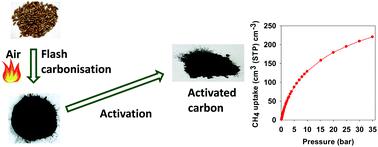当前位置:
X-MOL 学术
›
Energy Environ. Sci.
›
论文详情
Our official English website, www.x-mol.net, welcomes your
feedback! (Note: you will need to create a separate account there.)
Predictable and targeted activation of biomass to carbons with high surface area density and enhanced methane storage capacity
Energy & Environmental Science ( IF 32.4 ) Pub Date : 2020-07-21 , DOI: 10.1039/d0ee01340d Afnan Altwala 1, 2, 3, 4 , Robert Mokaya 1, 2, 3, 4
Energy & Environmental Science ( IF 32.4 ) Pub Date : 2020-07-21 , DOI: 10.1039/d0ee01340d Afnan Altwala 1, 2, 3, 4 , Robert Mokaya 1, 2, 3, 4
Affiliation

|
A challenge in the synthesis of activated carbons is that currently there is no way to prepare materials with predictable and targeted properties. In particular, there are no material parameters or characteristics of the starting carbonaceous matter that can be used to predict the porosity and packing density of the activated carbon. Here we report on the synthesis of biomass-derived activated carbons with targeted porosity and packing density that is suitable for methane storage. We show that the ratio of elemental oxygen to elemental carbon (i.e., O/C atomic ratio) of the precursor can be used as a universal predictor of the nature of porosity generated in an activated carbon. We use date seeds (Phoenix dactylifera) as an example of how biomass starting material with a very low O/C ratio, along with choice of mode of carbonisation, can be used to synthesise activated carbons with optimised porosity, as defined by the surface area density, and high packing density that is suitable for methane storage. The carbons store up to 222 cm3 (STP) cm−3 methane at 25 °C and 35 bar, which is much higher than any value reported to date for porous carbons, and is comparable to the best metal–organic-framework (MOF). However, the activated carbons are much cheaper (≤1$ per kg) compared to at best 10–20$ per kg for MOFs. Our findings present important insights on directed synthesis of optimised activated carbons and represent a significant step in the development of cheap porous carbons for high volumetric methane (or natural gas) storage. The findings are also applicable to informing the optimised preparation of activated carbons with targeted properties for other applications in energy storage and environmental remediation.
中文翻译:

可预测且有针对性地将生物质活化为具有高表面积密度和增强的甲烷存储能力的碳
活性炭合成中的一个挑战是,目前尚无方法制备具有可预测和目标性质的材料。特别地,没有起始碳质物质的材料参数或特性可用于预测活性炭的孔隙率和堆积密度。在这里,我们报告了具有目标孔隙率和适合甲烷存储的堆积密度的生物质衍生活性炭的合成。我们表明,前体中元素氧与元素碳的比率(即O / C原子比)可以用作活性炭中孔隙性质的通用预测指标。我们使用枣种子(Phoenix dactylifera)作为一个示例,说明如何使用具有非常低O / C比的生物质原料以及碳化方式的选择来合成具有最佳孔隙率的活性炭,孔隙率由表面积密度和高堆积密度定义适用于甲烷存储。碳最多可存储222 cm 3(STP)cm -3甲烷在25°C和35 bar的压力下,远远高于迄今为止报道的多孔碳的任何值,可与最佳的金属有机框架(MOF)相提并论。然而,相比于MOFs,每公斤最多10-20美元,活性炭要便宜得多(≤1美元/千克)。我们的发现为优化活性炭的定向合成提供了重要的见识,并代表了开发廉价的多孔碳用于高容量甲烷(或天然气)存储的重要一步。这些发现也可用于告知具有目标特性的活性炭的优化制备方法,以用于能量存储和环境修复的其他应用。
更新日期:2020-09-16
中文翻译:

可预测且有针对性地将生物质活化为具有高表面积密度和增强的甲烷存储能力的碳
活性炭合成中的一个挑战是,目前尚无方法制备具有可预测和目标性质的材料。特别地,没有起始碳质物质的材料参数或特性可用于预测活性炭的孔隙率和堆积密度。在这里,我们报告了具有目标孔隙率和适合甲烷存储的堆积密度的生物质衍生活性炭的合成。我们表明,前体中元素氧与元素碳的比率(即O / C原子比)可以用作活性炭中孔隙性质的通用预测指标。我们使用枣种子(Phoenix dactylifera)作为一个示例,说明如何使用具有非常低O / C比的生物质原料以及碳化方式的选择来合成具有最佳孔隙率的活性炭,孔隙率由表面积密度和高堆积密度定义适用于甲烷存储。碳最多可存储222 cm 3(STP)cm -3甲烷在25°C和35 bar的压力下,远远高于迄今为止报道的多孔碳的任何值,可与最佳的金属有机框架(MOF)相提并论。然而,相比于MOFs,每公斤最多10-20美元,活性炭要便宜得多(≤1美元/千克)。我们的发现为优化活性炭的定向合成提供了重要的见识,并代表了开发廉价的多孔碳用于高容量甲烷(或天然气)存储的重要一步。这些发现也可用于告知具有目标特性的活性炭的优化制备方法,以用于能量存储和环境修复的其他应用。











































 京公网安备 11010802027423号
京公网安备 11010802027423号